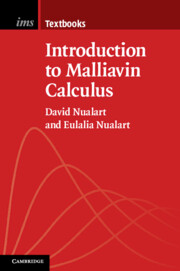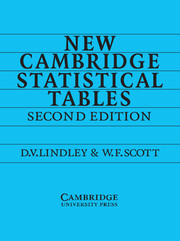Refine search
Actions for selected content:
2703 results in General statistics and probability
Foreword
-
- Book:
- High-Dimensional Probability
- Published online:
- 29 September 2018
- Print publication:
- 27 September 2018, pp xi-xii
-
- Chapter
- Export citation
Appendix A - Basics of Stochastic Processes
-
- Book:
- Introduction to Malliavin Calculus
- Published online:
- 14 September 2018
- Print publication:
- 27 September 2018, pp 221-227
-
- Chapter
- Export citation
9 - Deviations of Random Matrices and Geometric Consequences
-
- Book:
- High-Dimensional Probability
- Published online:
- 29 September 2018
- Print publication:
- 27 September 2018, pp 216-231
-
- Chapter
- Export citation
Contents
-
- Book:
- High-Dimensional Probability
- Published online:
- 29 September 2018
- Print publication:
- 27 September 2018, pp vii-x
-
- Chapter
- Export citation

Introduction to Malliavin Calculus
-
- Published online:
- 14 September 2018
- Print publication:
- 27 September 2018

New Cambridge Statistical Tables
-
- Published online:
- 12 September 2018
- Print publication:
- 03 August 1995
-
- Textbook
- Export citation
Frontmatter
-
- Book:
- Modelling Mortality with Actuarial Applications
- Published online:
- 28 April 2018
- Print publication:
- 03 May 2018, pp i-iv
-
- Chapter
- Export citation
2 - Data Preparation
- from Part One - Analysing Portfolio Mortality
-
- Book:
- Modelling Mortality with Actuarial Applications
- Published online:
- 28 April 2018
- Print publication:
- 03 May 2018, pp 20-44
-
- Chapter
- Export citation
Part One - Analysing Portfolio Mortality
-
- Book:
- Modelling Mortality with Actuarial Applications
- Published online:
- 28 April 2018
- Print publication:
- 03 May 2018, pp 1-2
-
- Chapter
- Export citation
6 - Model Comparison and Tests of Fit
- from Part One - Analysing Portfolio Mortality
-
- Book:
- Modelling Mortality with Actuarial Applications
- Published online:
- 28 April 2018
- Print publication:
- 03 May 2018, pp 94-111
-
- Chapter
- Export citation
References
-
- Book:
- Modelling Mortality with Actuarial Applications
- Published online:
- 28 April 2018
- Print publication:
- 03 May 2018, pp 355-360
-
- Chapter
- Export citation
Appendix A - R Commands
-
- Book:
- Modelling Mortality with Actuarial Applications
- Published online:
- 28 April 2018
- Print publication:
- 03 May 2018, pp 329-333
-
- Chapter
- Export citation
7 - Modelling Features of the Portfolio
- from Part One - Analysing Portfolio Mortality
-
- Book:
- Modelling Mortality with Actuarial Applications
- Published online:
- 28 April 2018
- Print publication:
- 03 May 2018, pp 112-131
-
- Chapter
- Export citation
Appendix C - Conversion to Published Tables
-
- Book:
- Modelling Mortality with Actuarial Applications
- Published online:
- 28 April 2018
- Print publication:
- 03 May 2018, pp 341-343
-
- Chapter
- Export citation
4 - Statistical Inference with Mortality Data
- from Part One - Analysing Portfolio Mortality
-
- Book:
- Modelling Mortality with Actuarial Applications
- Published online:
- 28 April 2018
- Print publication:
- 03 May 2018, pp 56-74
-
- Chapter
- Export citation
Part Two - Regression And Projection Models
-
- Book:
- Modelling Mortality with Actuarial Applications
- Published online:
- 28 April 2018
- Print publication:
- 03 May 2018, pp 161-162
-
- Chapter
- Export citation
16 - Competing Risks Models
- from Part Three - Multiple-State Models
-
- Book:
- Modelling Mortality with Actuarial Applications
- Published online:
- 28 April 2018
- Print publication:
- 03 May 2018, pp 294-306
-
- Chapter
- Export citation
12 - Methods of Graduation III: Two-Dimensional Models
- from Part Two - Regression And Projection Models
-
- Book:
- Modelling Mortality with Actuarial Applications
- Published online:
- 28 April 2018
- Print publication:
- 03 May 2018, pp 208-223
-
- Chapter
- Export citation
8 - Non-parametric Methods
- from Part One - Analysing Portfolio Mortality
-
- Book:
- Modelling Mortality with Actuarial Applications
- Published online:
- 28 April 2018
- Print publication:
- 03 May 2018, pp 132-144
-
- Chapter
- Export citation
3 - The Basic Mathematical Model
- from Part One - Analysing Portfolio Mortality
-
- Book:
- Modelling Mortality with Actuarial Applications
- Published online:
- 28 April 2018
- Print publication:
- 03 May 2018, pp 45-55
-
- Chapter
- Export citation
